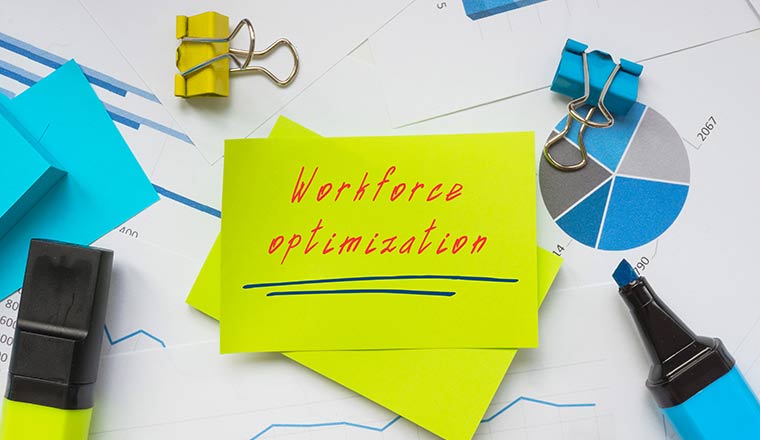
Contact centers serve as crucial touchpoints for businesses, facilitating customer interactions that directly impact satisfaction and loyalty. To ensure the success of these operations, optimizing the workforce becomes imperative. This article delves into the realm of workforce optimization in contact centers, exploring strategies, technologies, and best practices aimed at maximizing efficiency and elevating overall productivity. For additional insights and in-depth analysis, you can also refer to Gartner’s blog post on this topic.
Table of Contents
- Understanding Workforce Optimization (WFO) in Contact Centers:
- Strategies for Workforce Optimization in Contact Centers:
- Workforce Optimization Technologies:
- Best Practices for Workforce Optimization:
- Challenges and Considerations:
- The Future of Workforce Optimization:
- Conclusion: Elevating Contact Center Performance through Workforce Optimization
Understanding Workforce Optimization (WFO) in Contact Centers:
Workforce Optimization (WFO) in contact centers involves a holistic approach to enhance operational efficiency, employee performance, and customer satisfaction. It encompasses various elements, including workforce management, quality monitoring, performance analytics, and employee engagement.
Components of Workforce Optimization:
- Workforce Management (WFM): Efficiently managing staff schedules, forecasting call volumes, and ensuring optimal resource utilization.
- Quality Monitoring (QM): Regularly assessing and evaluating agent interactions to maintain service quality and compliance.
- Performance Analytics: Utilizing data-driven insights to measure and improve key performance indicators (KPIs).
- Training and Development: Providing continuous training to enhance skills, address gaps, and adapt to evolving customer needs.
- Employee Engagement: Fostering a positive work environment, recognizing achievements, and addressing employee concerns.

Strategies for Workforce Optimization in Contact Centers:
1. Implementing Robust Workforce Management:
- Forecasting and Scheduling: Utilize advanced forecasting tools to predict call volumes, enabling accurate agent scheduling.
- Real-Time Adherence: Monitor and manage agent adherence to schedules in real-time, ensuring optimal staffing levels.
2. Quality Monitoring and Assurance:
- Regular Call Monitoring: Implement a systematic process for monitoring calls to ensure adherence to quality standards.
- Feedback Mechanism: Provide constructive feedback to agents based on call evaluations, focusing on areas for improvement.
3. Leveraging Performance Analytics:
- Key Performance Indicators (KPIs): Define and track relevant KPIs such as average handling time, first-call resolution, and customer satisfaction scores.
- Data-Driven Insights: Use analytics tools to derive actionable insights from performance data, identifying trends and areas for improvement.
4. Continuous Training and Development:
- Personalized Training Plans: Tailor training programs to address individual agent strengths and weaknesses.
- Adaptable Learning Modules: Provide ongoing training that adapts to evolving customer expectations and industry trends.
5. Enhancing Employee Engagement:
- Recognition Programs: Establish recognition programs to acknowledge and reward outstanding performance.
- Regular Feedback: Foster a culture of open communication with regular feedback sessions and performance reviews.
6. Integrating Technology Solutions:
- Automated Workforce Management Systems: Invest in automated systems for workforce management, reducing manual workload and minimizing errors.
- Speech Analytics: Implement speech analytics tools to analyze customer-agent interactions for valuable insights.
Workforce Optimization Technologies:
1. Workforce Management (WFM) Software:
- Features: Forecasting, scheduling, and real-time adherence functionalities.
- Benefits: Optimized staffing levels, improved resource allocation, and enhanced operational efficiency.
2. Quality Monitoring (QM) Systems:
- Features: Call recording, evaluation, and feedback mechanisms.
- Benefits: Maintaining service quality, compliance adherence, and continuous performance improvement.
3. Speech Analytics Tools:
- Features: Speech recognition, sentiment analysis, and trend identification.
- Benefits: Extracting valuable insights from customer interactions, identifying areas for improvement, and enhancing service quality.
4. Performance Analytics Platforms:
- Features: Data visualization, KPI tracking, and trend analysis.
- Benefits: Informed decision-making, proactive issue identification, and continuous performance improvement.
5. Employee Engagement Software:
- Features: Recognition programs, feedback channels, and collaboration tools.
- Benefits: Improved employee satisfaction, enhanced morale, and a positive work culture.
Best Practices for Workforce Optimization:
1. Aligning Goals with Customer Expectations:
- Understand Customer Needs: Align workforce optimization strategies with customer expectations and industry benchmarks.
- Customer-Centric KPIs: Define KPIs that directly impact customer satisfaction and loyalty.
2. Regularly Updating Workforce Plans:
- Adaptability: Ensure workforce plans are adaptable to changing market conditions, seasonal variations, and emerging trends.
- Continuous Improvement: Regularly review and update workforce plans based on performance analytics and feedback.
3. Providing Continuous Feedback:
- Constructive Feedback: Offer constructive feedback to agents regularly, emphasizing positive reinforcement and areas for improvement.
- Two-Way Communication: Encourage agents to provide feedback on processes, tools, and training programs.
4. Prioritizing Employee Well-Being:
- Work-Life Balance: Strive to maintain a healthy work-life balance for agents by providing flexible scheduling options.
- Wellness Programs: Introduce wellness programs to support mental and physical well-being.
5. Integrating Multichannel Support:
- Omnichannel Approach: Integrate various communication channels to provide a seamless customer experience.
- Cross-Channel Training: Ensure agents are trained to handle interactions across different channels efficiently.
Challenges and Considerations:
1. Technology Integration:
- Challenge: Integrating new technologies seamlessly into existing systems.
- Consideration: Prioritize solutions that offer compatibility and ease of integration.
2. Balancing Automation and Human Touch:
- Challenge: Striking the right balance between automation and maintaining a personalized customer experience.
- Consideration: Implement automation for routine tasks, while reserving human interaction for complex issues.
3. Data Security and Privacy:
- Challenge: Ensuring data security and compliance with privacy regulations.
- Consideration: Implement robust security measures and regularly audit systems for compliance.
4. Employee Resistance to Change:
- Challenge: Overcoming resistance from agents to adopt new technologies or methodologies.
- Consideration: Involve agents in the decision-making process and provide comprehensive training and support during transitions.
The Future of Workforce Optimization:
1. Artificial Intelligence (AI) Integration:
- Predictive Analytics: AI-driven predictive analytics for more accurate forecasting and planning.
- AI-Powered Chatbots: Implementing AI-powered chatbots for efficient handling of routine queries.
2. Enhanced Employee Experience:
- Focus on Well-Being: Continued emphasis on employee well-being, with advanced wellness programs and mental health support.
- Remote Work Opportunities: Leveraging technology for remote work options, providing flexibility for agents.
3. Continuous Technological Evolution:
- Adoption of Emerging Technologies: Embracing emerging technologies such as augmented reality (AR) and virtual reality (VR) for enhanced training experiences.
- Intelligent Automation: Increasing reliance on intelligent automation for streamlined processes and enhanced efficiency.
4. Customer-Centric Optimization:
- Personalization: Customer-centric optimization with a focus on personalized interactions.
- Anticipating Customer Needs: Utilizing advanced analytics to anticipate and meet customer needs proactively.
Conclusion: Elevating Contact Center Performance through Workforce Optimization
In the ever-evolving landscape of contact centers, workforce optimization stands as a linchpin for success. By implementing robust strategies, leveraging advanced technologies, and prioritizing employee engagement, contact centers can navigate challenges and set the stage for sustained productivity and customer satisfaction. As the future unfolds, the integration of AI, a heightened focus on employee experience, and a commitment to continuous technological evolution will further shape the landscape of workforce optimization, ensuring that contact centers remain agile, efficient, and customer-centric in their operations.
